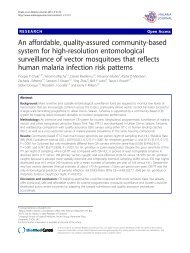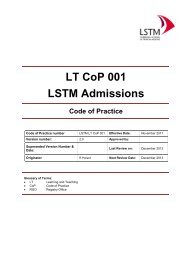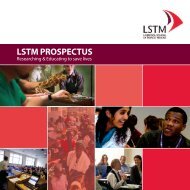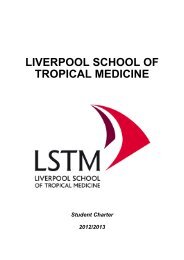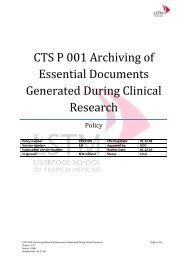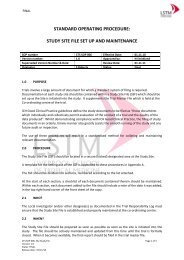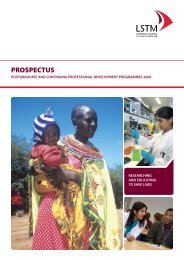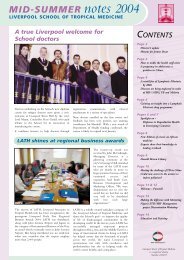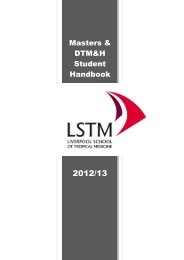Gender influences on child survival, health and nutrition: a ... - Unicef
Gender influences on child survival, health and nutrition: a ... - Unicef
Gender influences on child survival, health and nutrition: a ... - Unicef
You also want an ePaper? Increase the reach of your titles
YUMPU automatically turns print PDFs into web optimized ePapers that Google loves.
<str<strong>on</strong>g>Gender</str<strong>on</strong>g> Influences On Child Survival, Health And Nutriti<strong>on</strong>: A Narrative Review<br />
this secti<strong>on</strong> dem<strong>on</strong>strated that women’s multiple resp<strong>on</strong>sibilities (which often encompass domestic<br />
tasks, <strong>child</strong> care <strong>and</strong> paid labour) present a heavy burden <strong>on</strong> women which has potentially negative<br />
impacts for <strong>child</strong> <strong>health</strong> <strong>and</strong> nutriti<strong>on</strong> outcomes. Men, <strong>on</strong> the other h<strong>and</strong>, are often not expected to<br />
bear resp<strong>on</strong>sibility for domestic tasks or <strong>child</strong> care, which restricts the care opti<strong>on</strong>s for <strong>child</strong>ren whose<br />
mothers are over-loaded.<br />
Secti<strong>on</strong> 1.3 of the review focuses <strong>on</strong> the influence of gender norms, values <strong>and</strong> identities in relati<strong>on</strong> to<br />
<strong>child</strong> <strong>survival</strong>, <strong>health</strong> <strong>and</strong> nutriti<strong>on</strong>. Overall, it was found that socio-cultural values which perpetuate<br />
certain expectati<strong>on</strong>s about women’s <strong>and</strong> men’s capacities, characteristics <strong>and</strong> social behaviour underpin<br />
many of the imbalances between women <strong>and</strong> men viewed in the previous secti<strong>on</strong>s. These have serious<br />
c<strong>on</strong>sequences for <strong>child</strong> <strong>survival</strong>, <strong>health</strong> <strong>and</strong> nutriti<strong>on</strong>, especially in c<strong>on</strong>texts where gender bias against<br />
girls exists. There are also serious c<strong>on</strong>sequences for <strong>child</strong>ren exposed to domestic violence, a<br />
phenomen<strong>on</strong> which reflects gender discriminati<strong>on</strong> at its most extreme.<br />
Secti<strong>on</strong> 2 of the review focuses <strong>on</strong> evaluati<strong>on</strong>s of interventi<strong>on</strong>s which have used an aspect of genderawareness<br />
in their interventi<strong>on</strong> design with the aim of addressing issues around <strong>child</strong> <strong>health</strong> <strong>and</strong><br />
nutriti<strong>on</strong>. After an extensive search <strong>on</strong>ly five examples of relevant evaluati<strong>on</strong>s were identified. This is an<br />
area where further work is needed to design sufficiently sensitive strategies to evaluate gender-sensitive<br />
interventi<strong>on</strong>s. It is critical to explore the gender dynamics <strong>and</strong> processes leading to particular <strong>health</strong><br />
service user outcomes in order to underst<strong>and</strong> how gender roles <strong>and</strong> relati<strong>on</strong>s interact with interventi<strong>on</strong>s<br />
to influence <strong>child</strong> <strong>health</strong> <strong>and</strong> nutriti<strong>on</strong> outcomes <strong>and</strong> service utilisati<strong>on</strong> outcomes.<br />
Guidance <strong>on</strong> methodologies for researching gender <str<strong>on</strong>g>influences</str<strong>on</strong>g> <strong>on</strong> <strong>child</strong> <strong>survival</strong>, <strong>health</strong> <strong>and</strong> nutriti<strong>on</strong>:<br />
The guidance <strong>on</strong> methodologies for researching gender <str<strong>on</strong>g>influences</str<strong>on</strong>g> <strong>on</strong> <strong>child</strong> <strong>survival</strong>, <strong>health</strong> <strong>and</strong> nutriti<strong>on</strong><br />
draws <strong>on</strong> examples from the review <strong>and</strong> from other sources, to identify key aspects in c<strong>on</strong>ducting<br />
gender-sensitive research. Although the methods outlined are largely the same as those used for<br />
researching other topics, the guidance highlights ways in which these methods <strong>and</strong> tools can be used to<br />
elicit gender-sensitive informati<strong>on</strong> <strong>on</strong> <strong>child</strong> <strong>survival</strong> <strong>health</strong> <strong>and</strong> nutriti<strong>on</strong>.<br />
At the heart of gender-sensitive methods, is the need to reflect <strong>on</strong> the potential for any research topic,<br />
questi<strong>on</strong>, method or tool to elicit informati<strong>on</strong> <strong>on</strong> the different ways in which girls, women, boys <strong>and</strong><br />
men experience their status, roles, resp<strong>on</strong>sibilities, decisi<strong>on</strong>-making power <strong>and</strong> access to <strong>and</strong> c<strong>on</strong>trol<br />
over resources. The guidance highlights the importance of incorporating these c<strong>on</strong>siderati<strong>on</strong>s at every<br />
stage of the study design - as well as other cross-cutting factors such as age <strong>and</strong> socioec<strong>on</strong>omic status, in<br />
order to successfully c<strong>on</strong>duct gender-sensitive research. The guidance provides a step-by-step guide to<br />
methods <strong>and</strong> tools that can be used to explore <strong>and</strong> analyse how gender shapes <strong>child</strong> <strong>health</strong> <strong>and</strong><br />
nutriti<strong>on</strong> <strong>and</strong> also to design <strong>and</strong> evaluate resp<strong>on</strong>sive interventi<strong>on</strong>s from a gender perspective (including<br />
quantitative questi<strong>on</strong>naires, gender-sensitive indicators, qualitative interviewing techniques,<br />
Participatory Rapid Appraisal methods, am<strong>on</strong>g others). However it also highlights that the choice of<br />
method to use for a particular study will depend <strong>on</strong> a number of factors including: the setting, research<br />
questi<strong>on</strong> <strong>and</strong> topic, c<strong>on</strong>clusi<strong>on</strong>s sought <strong>and</strong> logistical issues.<br />
C<strong>on</strong>clusi<strong>on</strong>s from the Literature Review <strong>and</strong> Guidance <strong>on</strong> gender <strong>and</strong> <strong>child</strong> <strong>health</strong><br />
The literature review <strong>and</strong> guidance together highlight the urgent need for further use of gendersensitive<br />
approaches to research that addresses <strong>child</strong> <strong>health</strong> <strong>and</strong> nutriti<strong>on</strong> across a range of c<strong>on</strong>texts.<br />
This is important because of the critical role that such c<strong>on</strong>texts play in shaping the impact of gender<br />
dynamics. Efforts to address gender in <strong>health</strong> <strong>and</strong> nutriti<strong>on</strong> programming need to be widely shared to<br />
promote further learning <strong>and</strong> acti<strong>on</strong>. The c<strong>on</strong>siderati<strong>on</strong> of gender is an integral comp<strong>on</strong>ent of UNICEF’s<br />
broader commitment to ensuring equity in <strong>child</strong> <strong>health</strong> <strong>and</strong> nutriti<strong>on</strong>. Child <strong>health</strong> <strong>and</strong> nutriti<strong>on</strong><br />
EXECUTIVE SUMMARY<br />
6



